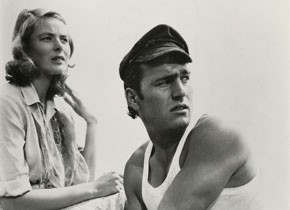Roberto Rossellini and Italian Neorealism
January 10 to February 8, 2007
Italian Neorealism of the 1940s and early 50s was the most influential movement in cinema history. The Film Museum's January Retrospective presents a comprehensive survey of this era; the season’s focus will be on the rich oeuvre of Roberto Rossellini (1906–1977), who ranks as one of the central figures in 20th Century culture.
Rossellini's international success with Roma, città aperta (1945) swiftly helped Neorealism attain widespread fame. Conceived while Italy was still occupied by the Nazis and shot immediately after the country's liberation, this dramatization of the partisan struggle became the basic model for the neorealist aesthetic, together with Vittorio De Sica's Ladri di biciclette (1948).
It was a "cinema of poverty" which portrayed the whole abundance of human experience. Neorealism, which can be seen as a symbolic rebirth of cinema after World War II, established a new film tradition, offering a countercurrent to glamourous Hollywood entertainment as well as the predictable patterns of propaganda films.
It has continued to inspire entire movements throughout the world ever since, from Cinéma vérité to Dogma 95, and helped shape many significant directors, whether they came from the USA (Cassavetes, Scorsese), India (Satyajit Ray) or Senegal (Ousmane Sembène).
The Retrospective starts out by showing the parallel paths of Roberto Rossellini and Neorealism's development from the Fascist era to the late 1950s. The film selection starts out with two rarely shown films from the 1941-42 season, when the term neorealismo was first used by Italian critics: Rossellini's semi-documentary feature La nave bianca and Francesco De Robertis' brilliant Alfa Tau! Both were part of a trilogy about naval battles during WW II and were under the overall direction of De Robertis, who was a forerunner of Neorealism and an Italian Naval Film Ministry Officer.
Another rarity can be found at the other end of the political spectrum: Aldo Vergano's Il sole sorge ancora (1946), one of the few Neorealist films with a Communist background; its co-author Guido Aristarco was one of the leading Marxist film critics of the time.
The famous directors associated with Neorealism are represented with several films in this survey. They include Vittorio De Sica; Luchino Visconti (who set an early milestone in 1943 with Ossessione); the frequently underrated Giuseppe De Santis (Riso amaro, Roma ore 11); Rossellini's onetime assistant and co-author Federico Fellini; and finally, Michelangelo Antonioni, who was searching for his own new approach to modern cinema in the 1950s, parallel to Rossellini.
In addition, there are works by Alessandro Blasetti, Luigi Zampa and Pietro Germi, as well as an unpolished document, produced by a group of directors, about the end of the War: Giorni di gloria (1945), a key film for the era.
The touch of "documentary” was also part of the revolutionary effect that Roma, città aperta had in 1945. After that, a neorealist paradigm was established: shot on location, with natural lighting; long takes with relatively few close-ups; dialogues in colloquial language; working class characters who were often played by non-professional actors (especially children); open-ended stories.
With the classics Paisà (1946) and Germania, anno zero (set amidst the ruins of Berlin in 1947), Rossellini completed his post-War trilogy and pushed the principles of the Neorealist movement to radical new heights.
The direction Rossellini took from the year 1950 onwards, with his increasing focus on ethical and societal concerns, was perceived by some as a "betrayal" of the principles of the movement. In France, however, with the emergence of the directors of the Nouvelle Vague, it was precisely his works from the 50s which led him to be considered the "father of modern cinema".
While film continued to be his window on the world, his passion for showing led to increasingly dialectic perspectives which defy easy interpretation. The tenor of his depiction of Francis of Assisi's works in the masterpiece Francesco, giullare di Dio (1950) is one of ecstatic humility.
That same year, he presented a contrastingly sober portrayal of a miracle in Stromboli, with Hollywood star Ingrid Bergman in the lead role. The love and work relationship between the two (accompanied by the constant scrutiny of the scandal sheets) lasted until 1954 and produced three children as well as six films. Some of these were almost autobiographical and rank amongst the most beautiful films in cinema history, including Europa '51 and Viaggio in Italia.
After his separation from Bergman, Rossellini devoted himself to an epic television series on India, which also resulted in the essayistic film India, Matri Bhumi (1957-59). Before his work took a completely new direction in the 1960s, he returned to the earliest years of neorealismo. Il generale Della Rovere (1959, with his colleague and a star actor from the Mussolini years, De Sica, playing a swindler colonel) and Era notte a Roma (1960) are calm yet extremely moving looks back on the period of Occupation and Resistance.
His work came full circle, while elsewhere, in the first films by Pier Paolo Pasolini and Jean-Luc Godard, for example, new stories and a new present were taking shape.
The realization of this Retrospective has been made possible thanks to the generous support of the Italian Cultural Institute in Vienna, the Cineteca Nazionale and Cinecittà Holding in Rome. Thanks also go to James Quandt and Olaf Möller for their detailed advice.


